Introduction of Flexible PCB
A flexible PCB is a special printed circuit board that uses the thin and bendable PI(polyimide) or PET (polyester)substrate to replace the rigid FR4 substrate.
Flexible PCB was invented to replace complex and numerous wire harnesses in compact spaces. By using flexible PCBs, the number of cable hardnesses and connectors is dramatically reduced, and the circuit wiring is more flexible and denser in small products.
It uses coverlay to replace the solder mask and non-conductive PI or PET materials to replace prepreg in conventional PCB.
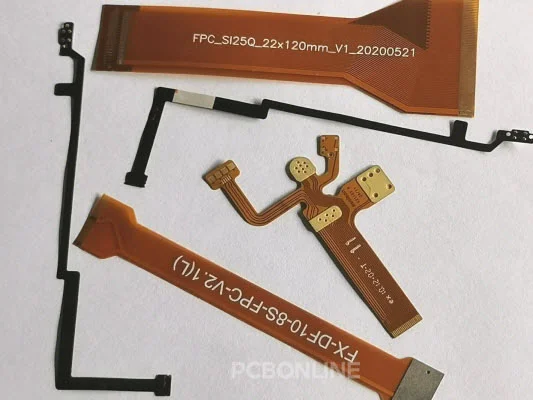
Flexible PCBs are extensively used in electronics devices and systems in telecommunications, automotive, industrial, medical, defense, aerospace, and consumer electronics. Why are flex PCBs so favored? Let's see the details of flexible PCBs.
What is Flexible PCB
A flexible PCB is also known as a flexible circuit board, flex PCB, or FPC (flexible printed circuit).
In a flexible PCB, copper circuit traces are etched on the non-conductive flexible PI or PET materials. Different circuit layers are interconnected by plated holes (PTH) or buried vias.
On the top and bottom of a flexible PCB, electronic components are surface-mounted on the PCB pads.
For better mechanical support, sometimes, PCB stiffeners are added to the ends of flexible PCBs for connection with the system/device/other parts.
Flexible PCBs are custom-designed and manufactured. They can be single-sided, double-sided, single-layer, dual-layer, or multi-layer.
The thickness range of flexible PCBs falls from 0.05mm to 0.6mm. This is also the finished flex PCB thickness range at the PCB manufacturer PCBONLINE.
Flexible PCBs are usually double-sided. To better understand flexible PCBs, you need to know the basic structure of flexible PCBs.
Structure of a Flexible PCB
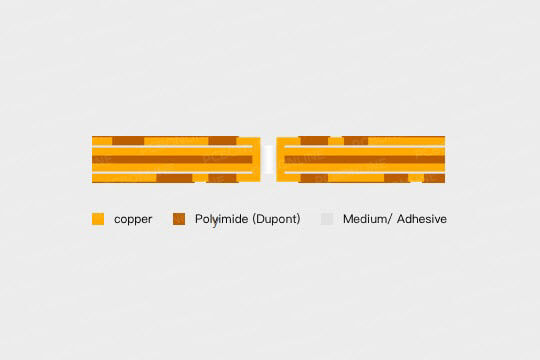
The above image shows the structure of a 4-layer flexible PCB with a PTH hole.
A flexible PCB consists of:
- PI/PET substrate. A PI or PET substrate is the core of an FPC. The PI material is typically yellow, and the PET substrate material is transparent.
- RA or ED copper foils. The copper foils are the circuit layers of a flexible PCB. RA copper is rolled annealed copper. It requires adhesive in flexible PCBs. ED copper is electrolytic copper. It doesn't require adhesive layers in an FPC. Thick-copper PCBs (3oz) must use RA copper.
- PI or PET layers. PI layers insulate the copper circuit layers, and the materials are the same as the substrate but only the thickness is smaller. The two external PI or PET layers of the coverlay, which is equal to the solder mask in normal PCBs.
- Adhesive layers. Adhesive layers are optional for flexible PCBs. They are between the RA copper layers and PI/PET layers. Flexible PCBs with adhesive layers have a larger PCB thickness.
- Flexible PCB vias. PCB vias are laser drilled on FPC layers and interconnect different circuit layers. The vias that penetrate all FPC layers are plated-through holes (PTH); vias that penetrate from the external layer to an internal layer are blind vias; vias that penetrate the internal layers are buried vias; vias with an aperture of 0.25mm and below that penetrate only one layer are micro vias.
- Flexible PCB stiffeners. Stiffeners are rigid connectors laminated at the end of flexible PCBs for connection with the system/device interfaces. Stiffeners are optional for flexible PCBs. There are FR4 stiffeners, PI stiffeners, and stainless steel stiffeners.
A single-layer flexible has a PI or PET substrate, a copper layer, and a coverlay.
A two-layer flexible PCB consists of a PI substrate, two rolled copper layers, and two PI layers (coverlay).
Multilayer flexible PCBs are manufactured by laminating two PI PCBs with adhesive in the middle. They have two PI or PET substrates.
Two-layer and multilayer flexible PCBs are double-sided PCBs.
Flexible PCB Types
According to circuit layer differences, there are single-layer FPC, two-layer FPC, and multilayer FPC.
According to component mounting side differences, there are single-sided FPC and double-sided FPC.
According to FPC laminate differences, there are yellow polyimide FPC, clear flexible PCBs, and flexible aluminum PCBs.
According to FPC vias differences, there are HDI flexible PCBs and normal flexible PCBs.
Here I give a brief introduction to some special flexible PCB types.
Transparent flexible PCB
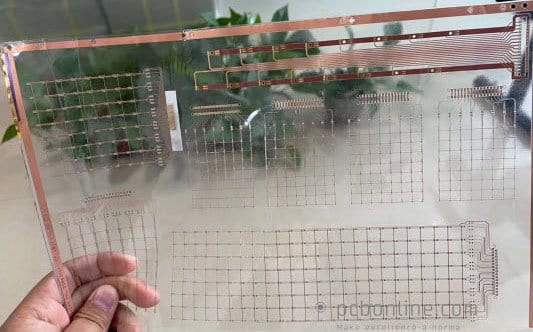
Transparent flexible PCBs use transparent flexible circuit material PET.
From the flexible PCB manufacturer PCBONLINE, the normal clear flexible PCBs have a thickness range of 0.06mm to 0.1mm, and a maximum PCB layer of 8.
The surface finish of clear flexible PCBs is usually immersion silver or immersion tin.
Clear flexible PCBs are about 5 to 10 times more expensive than normal yellow PI flexible PCBs.
The detailed price should be quoted according to your Gerber files. You can get free design/engineering help or a clear flexible PCB quotation by sending your Gerber to PCBONLINE at info@pcbonline.com.
HDI flexible PCB
HDI flexible PCBs are high-density-interconnect flexible PCBs that have buried/blind microvias.
According to IPC standards, HDI flexible PCBs have the FPC via an aperture of 0.25mm and below and a trace width/space of 0.1mm and below.
HDI flexible PCBs are multilayer, with a PCB layer of 4, 6, 8, or 10. You can have HDI flexible PCBs manufactured from PCBONLINE.
Flexible PCB Applications and Advantages
Flexible PCBs can be used in almost all electrical and electronics industries. However, flexible PCBs are more expensive than normal rigid PCBs, and they have been extensively used in these industries:
Flexible PCBs Used in Flexible LED Strips
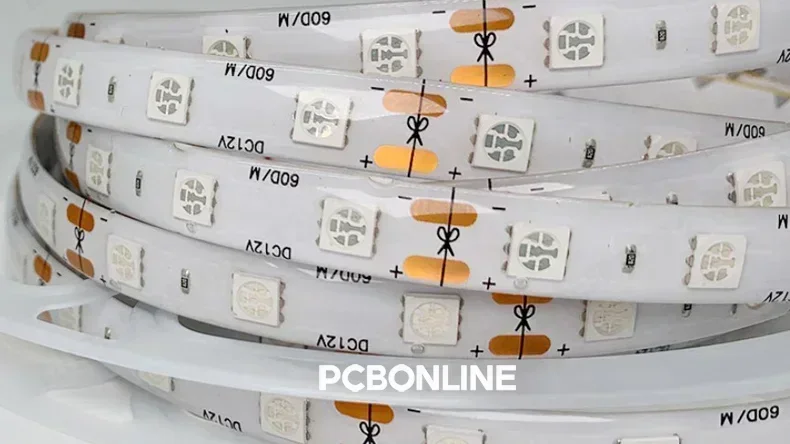
Flexible LED strips use flexible PCBs to mount LED chips.
Toll-to-toll is a popular fabrication method for flexible PCB LED strips. However, this fabrication method is suitable only for single-sided flexible PCBs.
At the flex PCB manufacturer PCBONLINE, the maximum length of the flexible LED strips is 200m.
Flexible PCB used in LED Displays
Transparent flexible PCBs are used in LED displays. LED chips are surface mounted on the PCBs and illuminate when powered on.
Transparent flex PCBs can attach to glass walls. They can illuminate RGB (green, green, blue) or RGBW (green, green, blue, white) lights.
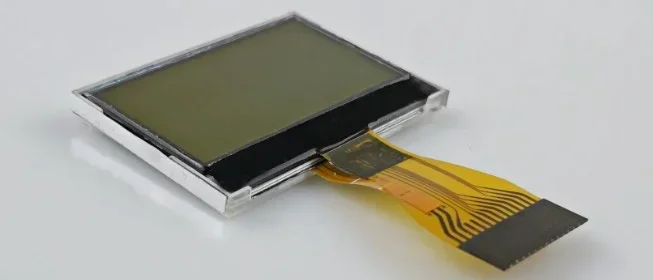
Besides transparent flexible PCBs, PI flexible PCBs are also used as LED screens in smartphones and touch screens on tablets. Especially, the folding screens use transparent flexible PCB.
Flexible PCBs in Automotive Electronics
Flexible circuit boards are used in automotive systems/parts including anti-lock braking systems, airbag controllers, dash systems, instrumental panels, etc.
Flex PCBs fit into the small parts and provide flexibility for engineers. Automotive components need to withstand heat and cold and experience vibration during use. There is no need to worry about flexible PCBs in such circumstances.
Flexible PCBs in Aerospace Components
Flexible PCBs are used in different parts of the aviation industry, such as in holographic waveguide helmet-mounted displays providing high-resolution 3D images.
In satellites, flexible PCBs are used to replace connectors that may cause interconnect errors, and they can fold and bend thousands of times, carry components, and directly connect different parts.
Flexible PCBs in computer electronics
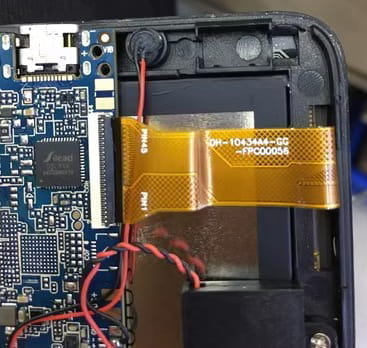
Computer operations rely on flexible PCBs as computers have a small space and flex PCBs pass signals. Desktops usually apply 4 and 6-layer FPC boards, and laptops with a smaller space require 8-layer FPC boards.
Flexible PCBs in smartphones
Smartphones are tiny, light-weighted, portable, and multifunctional. Inside the small smartphones, there are plenty of flexible PCBs used to carry and connect various components. Flex PCBs fit in tiny spaces and keep our smartphones safe, and they are resistant to heat and the environment.
Flexible PCBs in medical devices
Flexible PCBs are extensively used in medical appliances such as swallowable pill cameras, gastroscopy, glass hearing devices, etc. Flexible PCBs are small, thin, foldable, and durable, and these metrics make them necessary for medical devices that have a small space and require precision. Below is a double-sided flexible PCB for gastroscopy.
![]()
Besides, flexible PCBs are also used in wearable devices, digital cameras, etc. Flexible PCBs are extensively used in these middle and high-end devices because of the below advantages.
Advantages of Flexible PCBs
- Direct board-to-board/device connection, without the need for bulky cable connectors and wires.
- Lightweighted, thin, and smaller than conventional PCBs.
- Flexible, able to bend thousands of times without harm to the board.
- Able to withstand up to 400°C high temperatures.
One-Stop Flexible PCB Manufacturer - PCBONLINE
PCBONLINE is a one-stop flexible PCB manufacturer providing flexible PCB manufacturing, assembly, design, component sourcing, and end-product assembly.
PCBONLINE, founded in 1999, has two large advanced PCB manufacturing bases in Jiangsu and Jiangxi, and one flexible PCB assembly factory in Shenzhen.
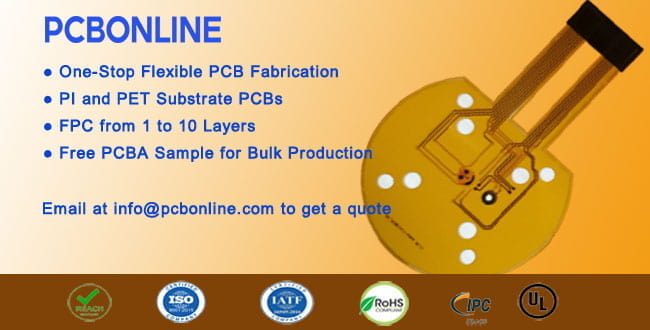
From PCBONLINE, you can order 1 to 10 layers of yellow polyimide flexible PCBs, 1 to 8 layers of clear flexible PCBs, single/double-sided flexible PCBs, HDI flexible PCBs, flexible aluminum PCBs, and aluminum LED PCBs.
Here are the reasons to let PCBONLINE manufacture your flexible PCBs:
- PCBONLINE provides turnkey flexible PCB manufacturing from FPC design, manufacturing, PCB assembly, and testing, to box-build assembly.
- High-quality flexible PCB manufacturing that passes ISO 9001, IATF 16949, UL, RoHS, and REACH certification.
- Free and professional one-on-one engineering/design assistance for flexible PCB customers.
- Free complete samples and PCBA functional testing for batch flexible PCB/PCBA orders.
- Traceable flexible PCB/PCBA manufacturing and quality money-back/free-rework guarantee.
Please feel free to contact PCBONLINE by email at info@pcbonline.com to get a flexible PCB quotation or free engineering consultancy.
Conclusion
This article gives a comprehensive introduction to flexible circuit boards. I hope you can have a deep insight into flexible PCBs by reading this article. If you want to know more specifications of flexible PCB manufacturing and assembly, or you want to design/manufacture/assemble flexible PCBs, please feel free to contact the reliable one-stop FPC manufacturer PCBONLINE.




